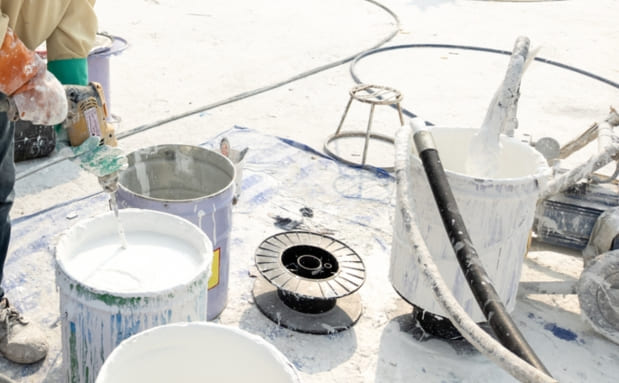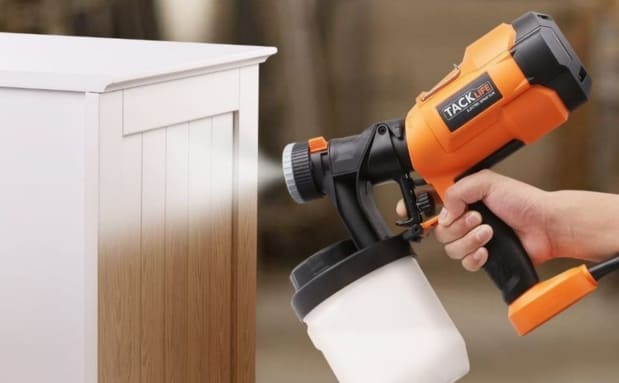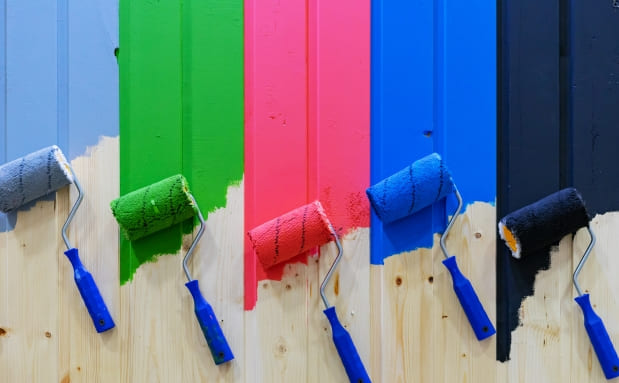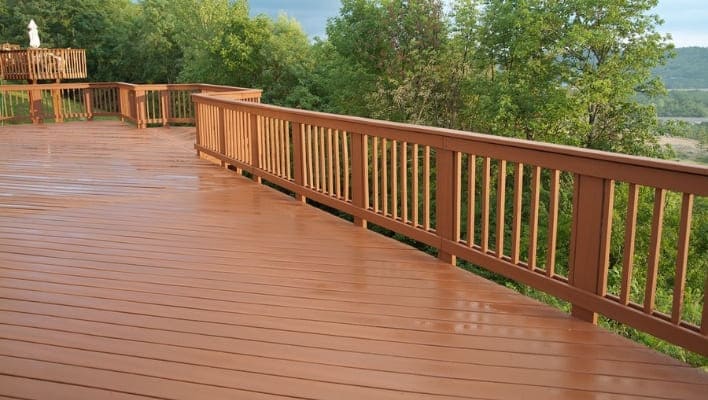Using a paint sprayer can undoubtedly revolutionize your painting projects, whether you’re tackling a room makeover or giving your outdoor furniture a fresh coat of color. It speeds up the painting process, covers large surfaces quickly, and provides a smooth, professional finish.
However, one common question that often comes to mind is “does a paint sprayer use more paint?” Should we opt for traditional painting methods using paint rollers or brushes?
As a DIYer myself, I’ll share this important aspect of paint sprayers, exploring the factors that influence paint consumption and offering insights to help you make a right decision about your next painting endeavor.
So, let’s uncover the truth about whether a paint sprayer consumes more paint or not.

Table of Contents
- Does A Paint Sprayer Use More Paint?
- Why Does My Paint Sprayer Use So Much Paint? – Factors That Affect Paint Consumption
- How Much Extra Paint Does a Spray Gun Use?
- How can we reduce paint waste?
- Spraying Vs Rolling: What Uses More Paint Spraying Or Rolling?
- When To Use A Paint Sprayer?
- Final Thoughts
- FAQs On does a paint sprayer use more paint
- Q. How good is spray paint compared to regular paint?
- Q. Is it better to paint a house with a brush or a sprayer?
- Q. Does using a spray gun have any disadvantages over using a paintbrush?
- Q. Can the paint sprayer save me time?
Does A Paint Sprayer Use More Paint?
According to Bob Vila, sprayers consume approximately 33 percent more paint than rollers and cover twice the square footage in the same time frame.
Paint sprayers break down the paint into tiny droplets, creating a fine mist. This mist covers surfaces more evenly but can lead to overspray, resulting in paint waste.
When it comes to paint coverage per gallon spraying with a paint sprayer, it’s wise to be generous in your estimate. A single gallon of exterior acrylic-latex paint typically covers a range of 150 to 200 square feet on a surface that is clean, already painted, or properly primed with minimal porosity, so it’s best to plan for the higher end of that range.
Why Does My Paint Sprayer Use So Much Paint? – Factors That Affect Paint Consumption
There are some important factors that contribute to a paint sprayer using more paint than traditional methods. Understanding these factors can help you manage your paint consumption more effectively. Let’s look into them:
- Type of Paint: Different types of paint have varying viscosities and coverage capabilities. Thicker paints, such as oil-based or latex enamel, might require more paint to achieve a satisfactory finish compared to thinner paints like latex.
- Spray Pattern and Pressure Settings: The spray pattern and pressure settings on your paint sprayer can significantly impact paint consumption. If you use a wide spray pattern and high pressure, you might end up using more paint than is necessary. Adjusting these settings to match the specific project and surface can help minimize paint waste.
- Type of Spray Gun: The type of spray gun you use can also affect paint consumption. There are different types of spray guns, such as HVLP and airless sprayers. HVLP sprayers tend to be more efficient in terms of paint usage compared to airless sprayers because they operate at lower pressure and produce less overspray.
- Surface Texture and Porosity: The texture and porosity of the surface you are painting can impact paint consumption. Rough or porous surfaces may absorb more paint, requiring additional coats to achieve proper coverage. Smoother surfaces tend to use less paint.
- Nozzle and Tip Size: The size of the nozzle and tip on your paint sprayer can also influence paint usage. A larger nozzle and tip size will result in a higher paint flow rate, potentially using more paint. Smaller nozzles and tips can provide finer control over paint application and reduce consumption.
- Weather Condition: For efficient and resource-saving painting, you should apply paint when the surface and ambient temperatures are within 50-90 degrees Fahrenheit, while the relative humidity ranges from 30-80%, reported by By Arashi Young (source).
How Much Extra Paint Does a Spray Gun Use?

A spray gun can consume about 20% to 50% more paint compared to traditional brush or roller methods. The reason behind the increased paint consumption lies in the efficiency and speed of paint sprayers.
With careful planning and adjustments, you can minimize the extra paint consumption associated with paint sprayers.
| Painting Method | Paint Needed (Cans) | Paint Wastage | Application |
| Brush and Roller | 1 can of paint | Minimal | Roll or brush paint evenly. |
| HVLP Sprayer (Indoors) | 1.2 cans of paint | 20% – 50% | Adjust spray pattern and pressure for control. |
| HVLP Sprayer (Outdoors) | 1.5 cans of paint (or more) | Varies by conditions | Ideal for outdoor projects, considering weather conditions. |
| Airless Sprayer | 1.4 cans of paint (or more) | 50% or more | Suitable for large surfaces, adjust pressure for even coverage. |
This ratio can vary slightly, especially depending on PSI. On windy days outdoors, you might find yourself needing a ratio as high as 2:1 or even 3:1 to achieve the desired coverage.
How can we reduce paint waste?
| Step | Action |
| 1. Choose the right sprayer | Select an appropriate sprayer type (e.g., HVLP) for your project. |
| 2. Replace worn tips | Discard worn or rusted spray tips to maintain an even fan pattern. |
| 3. Adjust spray pressure | Keep pressure as low as possible while achieving the desired film thickness. |
| 4. Maintain proper distance | Make sure you maintain an even distance from the surface. |
| 5. Avoid windy days | Paint on calm days to prevent overspray and maximize paint on the target. |
| 6. Stack items for overspray | Position items to catch overspray, reducing wasted paint. |
| 7. Spray fences efficiently | Spray fence sections from the side to minimize overspray between slats. |
| 8. Use a paint strainer | Remove debris from paint to prevent clogs and ensure even application. |
| 9. Clean equipment | Thoroughly clean your spray gun and equipment after each use to prevent issues. |
Useful Resource: Save money and minimize paint waste with our painting tips, including selecting the right paint can sizes.
Spraying Vs Rolling: What Uses More Paint Spraying Or Rolling?

Comparing spraying and rolling, it’s important to note that sprayers typically use approximately 33 percent more paint compared to rolling. You can save money by rolling paint as it is an affordable option.
For interior wall painting, a roller is the preferred tool, ensuring smooth and uniform coverage. Meanwhile, a sprayer offers versatility, suitable for both interior and exterior walls, as well as rough surfaces such as concrete and brick. When it comes to uneven surfaces, rolling paint can be a challenging and impractical option.
When To Use A Paint Sprayer?
A sprayer is useful:
- When working in an empty interior space, allowing for efficient coverage without the need to protect furniture or belongings.
- When applying textured finishes to walls, as it can evenly distribute the texture for a uniform look.
- It is useful for detailing surfaces and textured materials.
- Where masking and protecting surrounding areas is not a concern, as it can expedite the painting process.
Final Thoughts
Using a paint sprayer can make your painting job faster and yield impressive coatings but often uses 2-3 times more paint than those of traditional methods due to factors like overspray and settings. Following the above guide on “does a paint sprayer use more paint” can help you balance efficiency with paint conservation through careful planning for successful DIY painting works.
FAQs On does a paint sprayer use more paint
Q. How good is spray paint compared to regular paint?
Applying just one coat of spray paint can achieve the same flawless results as applying six coats with a brush, all without the imperfections of stray bristles or brush marks.
This efficiency not only reduces the need for multiple coats but also ensures a smoother finish that is considerably less prone to chipping.
Q. Is it better to paint a house with a brush or a sprayer?
If you’re working on a tight schedule, opting for a sprayer is the more efficient choice as compared to a brush. Furthermore, the type of finish you want is important to consider; brushes often result in visible brush lines, whereas spraying typically delivers a smoother and more polished finish.
Q. Does using a spray gun have any disadvantages over using a paintbrush?
Beginners may struggle with challenges like drips, runs, and over-spray, leading to an uneven application with some areas having too much paint buildup while others remain thinly coated. Furthermore, a paint spray consumes approximately 2-3 times more paint than a brush or roller, and the excess paint does not adhere to the intended surface.
Q. Can the paint sprayer save me time?
On average, a paint sprayer can save you a considerable amount of time. Painting with a sprayer is typically three to four times faster than using a roller for the same area, which leads to a time savings of about 10-25 seconds per pass using a paint sprayer.


